It seems like everyone looks at porn, especially now that the Internet makes it so easily available. Some surveys show that around 70% of men and 30% of women regularly look at pornography.
So you might be wondering what the big deal is. If so many people are viewing porn, what could be wrong with it?
Here are 5 things to consider before you watch porn.
1 - Watching porn has similar effects on your brain as using drugs.
When you watch porn, your brain releases surges of dopamine, a thrilling feel-good chemical. Repeated surges of dopamine can desensitize your brain to the feel-good effect, so you need more stimulus for the same good feeling. This is why drug addicts need bigger “hits” for the same effect. The same is true for pornography – you gradually need more porn, or more graphic porn, for the same feelings of excitement and thrill.
A 2014 Cambridge University study revealed similarities in the brains of people addicted to pornography and people addicted to alcohol. Brain scans showed that a porn addict’s brain reacts the same when presented with a pornographic image as an alcoholic’s brain does when presented with an image of alcohol.
2 - Porn makes you lonely and more likely to have psychological issues.
Most people who regularly look at pornography are not proud of it and don’t tell everyone about the habit. Studies show that people who hide distressing or shameful things about themselves (self-concealment) are at higher risk for depression, loneliness, anxiety, and even suicide. For people who are looking at porn a lot, these feelings can also be combined with body image issues, a poor self-image, and insecurity.
3 - Porn can hurt your partner.
People who use porn even casually admit that they become less attracted to their partners. And as porn use increases, so does the dissatisfaction with a partner’s looks, sexual performance, and willingness to try new sexual acts. Women whose male partners view pornography report a feeling that they can never measure up to the partner’s expectations or desires. Women often also report feelings of betrayal and mistrust when they learn that their partner has been viewing porn.
4 - Excessive use of porn can cause sexual dysfunction.
Men who view a lot of pornography experience erectile dysfunction, delayed orgasm, inability to reach orgasm, and even a loss of pleasure in general. Mental health experts believe that as porn use increases, people experience emotional and relational disconnections when it comes to sex. Sex becomes something you do alone rather than something that requires intimacy and connection in a relationship.
5 - Pornography presents a false view of sexuality.
Porn isn’t real. It offers an unreal view of relationships and sex. Some porn normalizes dangerous sexual behaviors – like sex with strangers or group sex. Some porn normalizes degrading, harmful sexual behaviors – like rape or brutal anal sex or women being humiliated. And it’s not only about the unhealthy things that are shown, it’s also about the healthy things that aren’t shown – things like cuddling, kissing, and partners being responsive to each other’s needs and preferences.
We’re made for relationships and connection with other people. Pornography allows people to separate sexual satisfaction from emotional intimacy. It rewires our brains to associate sexual pleasure with images that aren’t real and makes it harder for us to experience pleasure and satisfaction with a real, live partner.
We want to help you thrive in a healthy relationship. If you’re struggling with a pornography addiction, we’re here to listen and help you. If your partner is addicted to porn, we’re here for you too.





